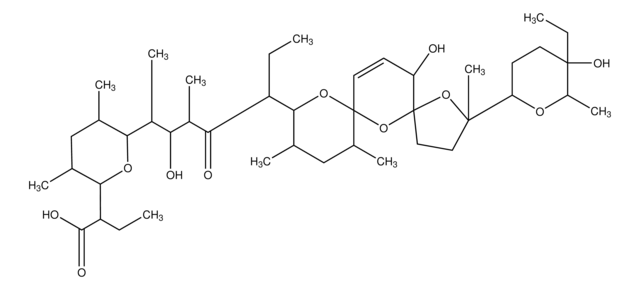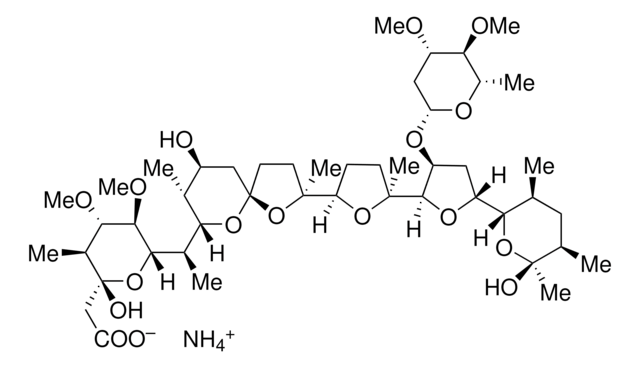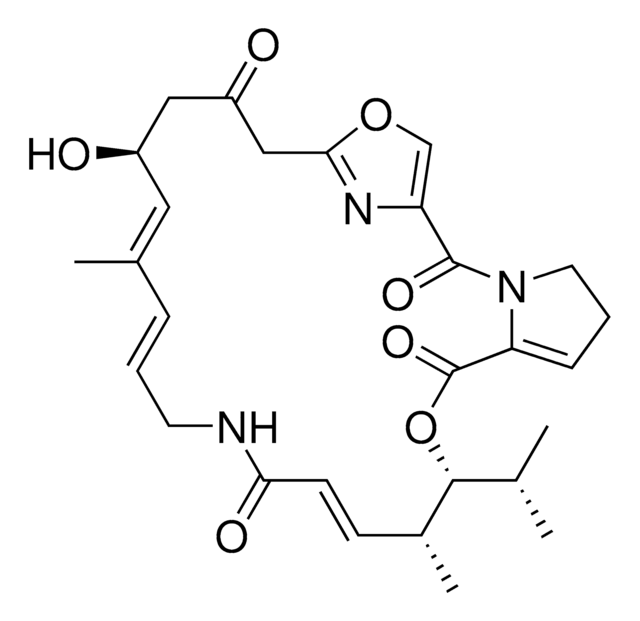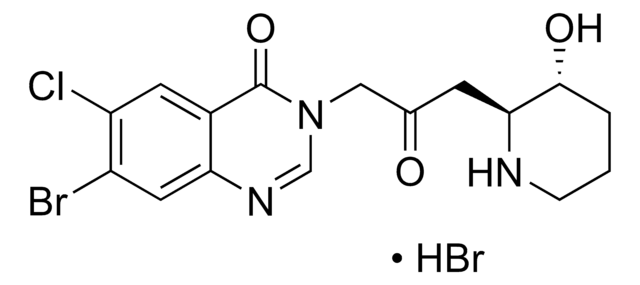N1271
Narasin from Streptomyces auriofaciens
≥98% (HPLC)
Synonim(y):
4-methylsalinomycin, Monteban, narasin A
About This Item
Polecane produkty
Poziom jakości
Próba
≥98% (HPLC)
Postać
powder
rozpuszczalność
methanol: soluble 20 mg/mL
spektrum działania antybiotyku
Gram-positive bacteria
fungi
viruses
Tryb działania
cell membrane | interferes
temp. przechowywania
−20°C
ciąg SMILES
CCC(C1OC(C(C)CC1C)C(C)C(O)C(C)C(=O)C(CC)C2OC3(OC4(CCC(C)(O4)C5CCC(O)(CC)C(C)O5)C(O)C=C3)C(C)CC2C)C(O)=O
InChI
1S/C43H72O11/c1-12-30(35(46)27(8)34(45)28(9)36-23(4)21-24(5)37(51-36)31(13-2)39(47)48)38-25(6)22-26(7)42(52-38)18-15-32(44)43(54-42)20-19-40(11,53-43)33-16-17-41(49,14-3)29(10)50-33/h15,18,23-34,36-38,44-45,49H,12-14,16-17,19-22H2,1-11H3,(H,47,48)
Klucz InChI
VHKXXVVRRDYCIK-UHFFFAOYSA-N
Powiązane kategorie
Zastosowanie
Działania biochem./fizjol.
Hasło ostrzegawcze
Danger
Zwroty wskazujące rodzaj zagrożenia
Zwroty wskazujące środki ostrożności
Klasyfikacja zagrożeń
Acute Tox. 2 Oral
Kod klasy składowania
6.1A - Combustible acute toxic Cat. 1 and 2 / very toxic hazardous materials
Klasa zagrożenia wodnego (WGK)
WGK 3
Temperatura zapłonu (°F)
Not applicable
Temperatura zapłonu (°C)
Not applicable
Środki ochrony indywidualnej
Eyeshields, Faceshields, Gloves, type P3 (EN 143) respirator cartridges
Certyfikaty analizy (CoA)
Poszukaj Certyfikaty analizy (CoA), wpisując numer partii/serii produktów. Numery serii i partii można znaleźć na etykiecie produktu po słowach „seria” lub „partia”.
Masz już ten produkt?
Dokumenty związane z niedawno zakupionymi produktami zostały zamieszczone w Bibliotece dokumentów.
Klienci oglądali również te produkty
Nasz zespół naukowców ma doświadczenie we wszystkich obszarach badań, w tym w naukach przyrodniczych, materiałoznawstwie, syntezie chemicznej, chromatografii, analityce i wielu innych dziedzinach.
Skontaktuj się z zespołem ds. pomocy technicznej
















